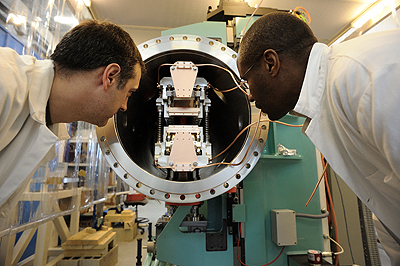LSU Libraries, LSU CAMD, host scientific photo exhibition highlighting Synchrotron Technology
LSU Libraries is set to host a scientific photo exhibition and pair of lectures this fall showcasing both the SOLEIL synchrotron research facility located at the Campus Paris-Saclay in France and LSU’s Center for Advanced Microstructures and Devices, or CAMD.
 From Oct. 21 through Nov. 14, the lobby of LSU’s Middleton Library will host the photographic display, while a pair of lecture events in conjunction with the exhibit will take place in the lecture hall at nearby Hill Memorial Library on Oct. 21 and Oct. 29. The exhibition and lectures series are free and open to the public.
From Oct. 21 through Nov. 14, the lobby of LSU’s Middleton Library will host the photographic display, while a pair of lecture events in conjunction with the exhibit will take place in the lecture hall at nearby Hill Memorial Library on Oct. 21 and Oct. 29. The exhibition and lectures series are free and open to the public.
The events are organized by the Office for Science & Technology at the Embassy of France in the United States and LSU CAMD. In addition, partners for the project include photographer Vincent Moncorgé; Bloom Artist; the SOLEIL French national synchrotron facility; and the Centre National de la Recerche Scientifique.
An independent photographer based in Lyon, France, Moncorgé works as a photo journalist and portraitist with the national press, regional governments, companies and communication agencies. In conjunction with his commissioned work, he has been working on a long, personal project that seeks to put a face on “what science does.” To this end, he has worked closely for several years with French entities, scientific institutions, as well as numerous laboratories. To celebrate the first decade of the SOLEIL synchrotron, a multidisciplinary instrument and research laboratory, Moncorgé spent day and night capturing the rich kaleidoscope of technological and human skills on display at the laboratory.
A synchrotron is most easily described as a giant lamp, measuring 150 meters, that lights up matter. At SOLEIL, the synchrotron radiation is provided by the circulation of high energy electrons traveling at nearly light speed in a 354-meter ring. The synchrotron beam, which is the size of a hair and is 10 times brighter than sunlight, offers the entire spectrum of white light, far infrared to X-ray region, including ultraviolet very hard X-rays. It is harnessed through 26 different beam lines, each of them serving as a laboratory dedicated to specific analysis and experiments either on solids, gases, liquids or living matter, revealing their most amazing and promising properties. To learn more about the SOLEIL synchrotron facility, visit www.synchrotron-soleil.fr.
Similarly, CAMD is a synchrotron radiation research center located at LSU. One of only seven in the U.S. and the only one in the South, CAMD’s mission is to provide infrastructure for research and education in synchrotron-based science and technology based on utilization of radiation, infrared to hard X-ray, produced by the 1.3-gigaelectronvolt synchrotron. There are 14 beam lines transmitting select beams of radiation to specific experiment stations at CAMD using 1.3 GeV light. Research is conducted by scientists and engineers from Louisiana universities, along with distinguished scientists from national and international institutions in the areas of energy, environment, medical/biomedical, and microfabrication. CAMD has recently added a multi-pole wiggler to provide more a much extended spectrum of radiation to greatly enhance research opportunities. More information on LSU CAMD can be found at www.camd.lsu.edu.
“The Goldsmiths of Light” exhibition will give students, faculty, and the general public the unique opportunity to discover this last-generation research equipment through a virtual visit in photography and the various scientific fields which benefit from this tool.
In conjunction with the exhibition, an interactive lecture series will also provide greater details into the topic of documenting science and the scientific topic of the synchrotron radiations and showing how it can contribute to different fields.
The first lecture, “Documenting Science,” will take place on Tuesday, Oct. 21, at 3:30 p.m. During this event, Moncorgé will discuss his experience on documenting science through photography. Following a short historical exploration from the late 19th century and French photographer Etienne Jules Marey’s chronophotograph, he will detail the new modern story-telling strategies the scientific community is facing today. Then, Moncorgé will relate his own personal experiences with photographing synchrotron daily life to model organisms such as tiny Drosophila flies.
Both CNRS Director of Research Amina Taleb-Ibrahimi and LSU Professor of Biological Sciences Marcia Newcomer will speak at the Oct. 29 lecture. Taleb-Ibrahimi will give a general overview of the synchrotron radiation, with a broad range of applications of high brilliance X-ray sources in different fields such as protein crystallography, medical sciences, environmental sciences, ancient materials, physics and chemistry. Meanwhile, Newcomer’s talk will be an overview of the variety of biomedical topics that can be addressed by LSU researchers using synchrotron radiation.
MEDIA NOTE: Media are invited to view the exhibit and attend the lectures, and interviews with lecturers are available upon request.
Contact Aaron Looney
LSU Media Relations
225-578-3871
alooney@lsu.edu
